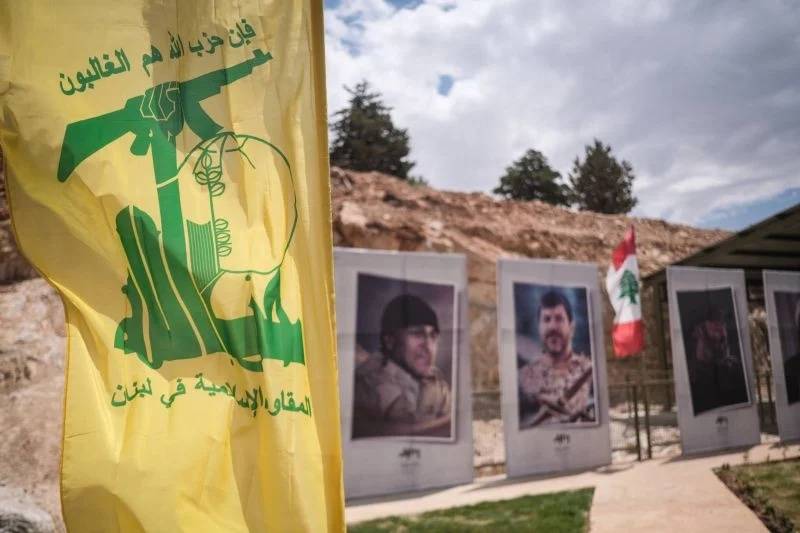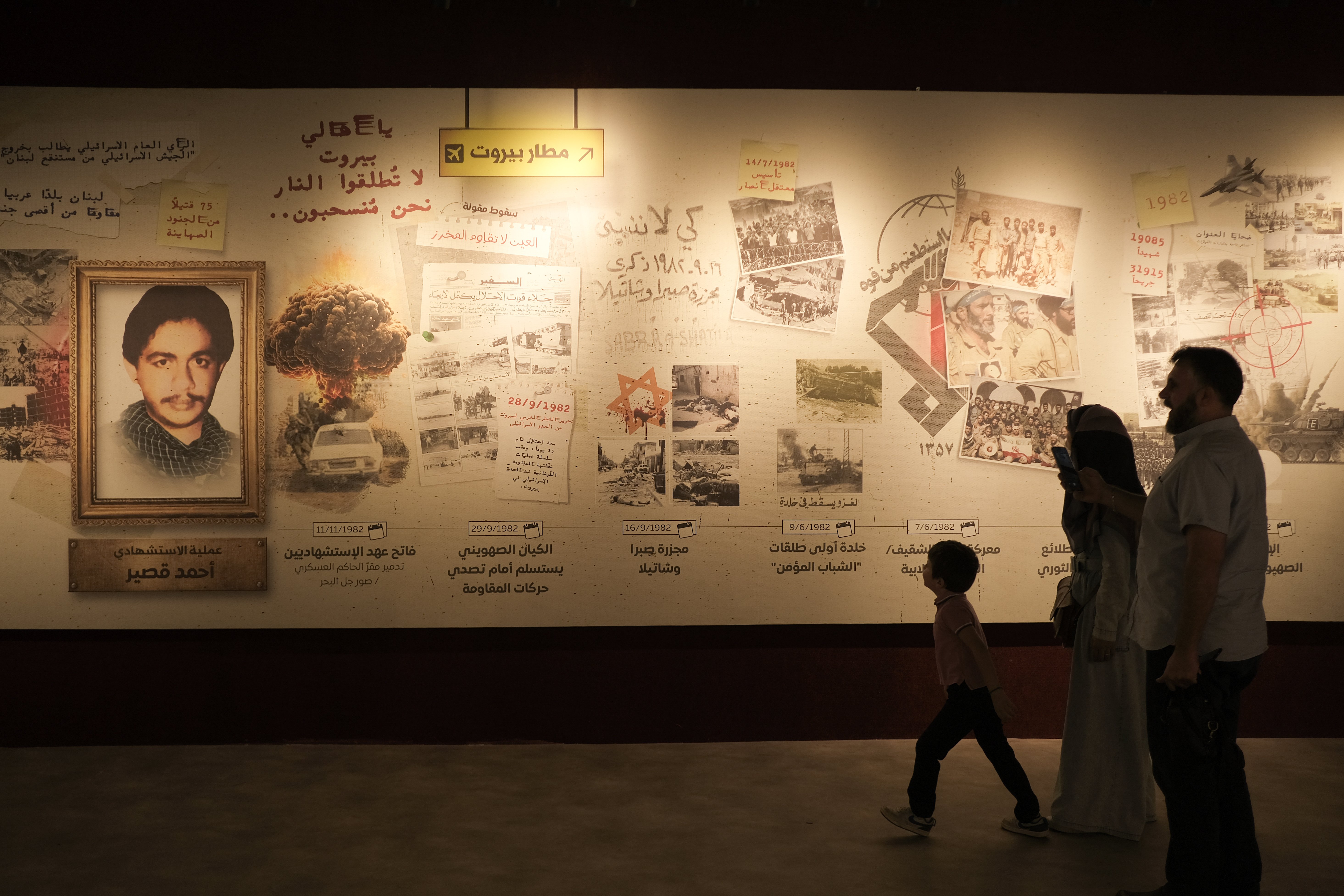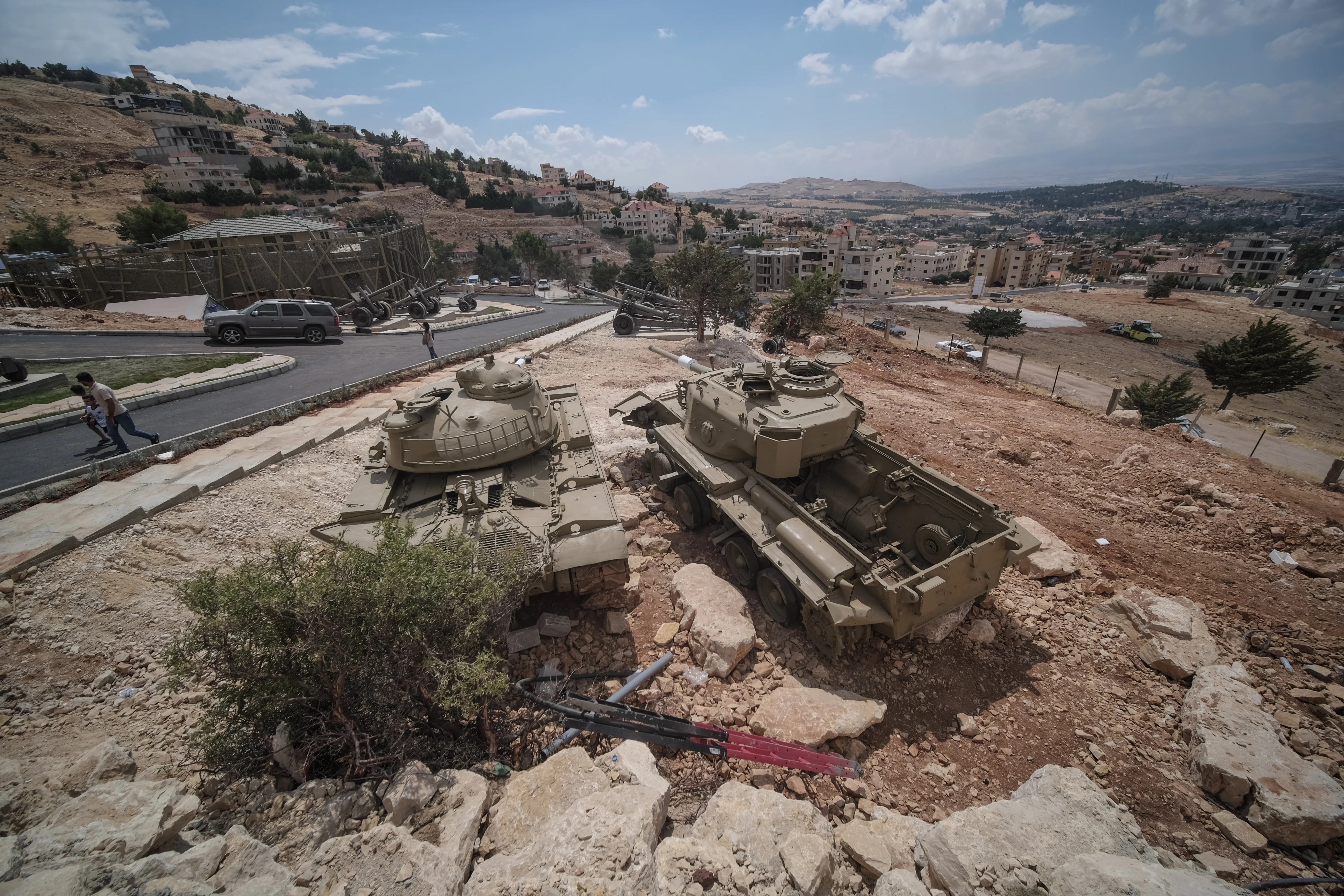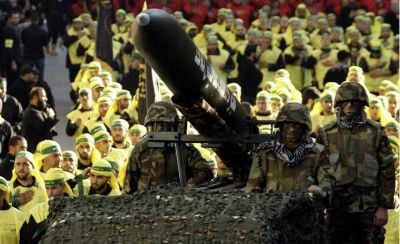
Portraits of slain party figures hang in the Baalbeck “Jihadi Museum.” (Credit: João Sousa/L'Orient Today)
A new tourist attraction has emerged on the heights of Baalbeck. Just a few hundred meters from the Temple of Bacchus, a distinctive museum was recently inaugurated: Hezbollah’s “Jihadi Museum.” The choice of location holds great symbolism, as it was in this Bekaa town that the armed group was established in 1982, and it was on this very hill that the party’s initial military exercises took place.
Inaugurated on Aug. 26, the building commemorates what Hezbollah leader Hassan Nasrallah declared Lebanon’s “second liberation.” This proclamation came as the last remaining Islamic State (Daesh) militants were evacuated from the country in 2017, a development that was part of a contentious agreement overseen by Nasrallah.
“This museum represents our history and our bravery,” said Ahlam, a resident of Baalbeck. “We’ve been waiting for it for a long time.”
Ahlam expressed hope that her six offspring will follow in the footsteps of their father, who is a fighter within the party.
The new museum is not as extensive as the one in Mlita. It doesn’t have bunkers, underground passages or propaganda videos playing on a loop like at the Mlita museum.
The Mlita museum, situated in southern Lebanon, was opened a decade after the Israeli withdrawal from Lebanon in May 2000.
A banner featuring the portrait of Nasrallah greets visitors at the entrance.
Along the road leading to one of the main areas of the site, cannons are displayed. Inside a fortress covered with camouflage netting, there’s a “chronological frieze of the memory of the resistance” welcoming visitors.
There are also portraits of party militants who died and important figures like Imad Moughniyeh, the former head of Hezbollah’s military operations who was assassinated in Damascus in 2008.
Similar to the Mlita museum propaganda video, the frieze in this museum celebrates the “resistance,” reflecting on the party’s inception, its various suicide bombings, the liberation of the South, and the “great divine victory” against Israel in 2006.
 Visitors discover a “timeline of the memory of the resistance” in the new Hezbollah museum. (Credit: João Sousa/L'Orient Today)
Visitors discover a “timeline of the memory of the resistance” in the new Hezbollah museum. (Credit: João Sousa/L'Orient Today)
However, there’s an additional aspect highlighted: the military involvement in Syria that started in 2013. This intervention was aimed at supporting the regime of Syrian President Bashar al-Assad and securing the land route connecting Syria to Iran.
In the newly founded museum, the military engagement is glorified and depicted as a “war orchestrated by the Americans and Zionists to weaken the resistance,” as the guide explains.
Meanwhile, Mirvat, a visitor at the museum, told L’Orient-Le Jour, “The history of independent Lebanon traces back to the founding of Hezbollah. It’s because of the sayyed and the resistance that I can proudly call myself Lebanese.”
‘The spoils of war’
From the exterior, the museum resembles a military base with tanks, armored vehicles, missiles, air defense systems, kamikaze drones and all-terrain vehicles scattered around. The roughly 100 military vehicles and components showcased here are considered “spoils,” acquired partly during the Israeli occupation and subsequently during Hezbollah’s military involvement in Syria.
“We took some weapons from the hands of the ‘takfiris,’ and others were donated by the Damascus regime,” said one of the many former fighters who has become a tourist guide at the museum and who introduced himself to L’Orient-Le Jour as Haj Hamzi.
“We got them in overnight,” he said. “We can get them out just as quickly if need be,” he added, showcasing his favorite device, a “Sam 6,” an anti-aircraft weapon system equipped with surface-to-air missiles.
“We’ve got much better stuff; here we’re only showing the remains,” said Djibril, his sidekick.
Meanwhile, at a time when a large segment of Lebanese public opinion is calling for the disarmament of Hezbollah, notably following the security incident that took place in Kahaleh on Aug. 9, when a gunfight broke out between the town’s Christian inhabitants and some party members following the overturning of a Hezbollah-owned truck transporting munitions in the area.
 The new Hezbollah museum, where military artillery is on display. (Credit: João Sousa/L'Orient Today)
The new Hezbollah museum, where military artillery is on display. (Credit: João Sousa/L'Orient Today)
According to some analysts, the newly established museum is not a deliberate provocation but rather part of Hezbollah’s broader “cultural” strategy.
“It’s about reshaping the narrative of Lebanese Shiites,” said Mohannad Hage Ali, a researcher at the Carnegie Middle East Center.
“Museums are typically meant to showcase a nation’s shared history,” he said. “While Lebanon struggles to maintain its national museum, Hezbollah is expanding its network, focused on its intertwined dual identity of resistance and Khomeinist Islam.”
But is this expansion happening with unofficial consent from the authorities?
“When the resistance was established, we didn’t seek anyone’s permission,” Haj Hamzi said.
L’Orient-Le Jour reached out to Lebanon’s Tourism Ministry, which clarified that the site falls under the jurisdiction of the Culture Ministry because “it’s a museum.”
This claim was contradicted by caretaker Culture Minister Mohammad Mortada, who is close to Hezbollah. In a statement to L’Orient-Le Jour, Mortada asserted that the “museum” constitutes “an exhibition” because it primarily features weapons rather than historical ruins.
Referring to the term employed by his political ally, Mortada added, “We’re going to request that they use the term ‘exhibition.’”
This article was originally published in French in L'Orient-Le Jour. Translation by Sahar Ghoussoub.
